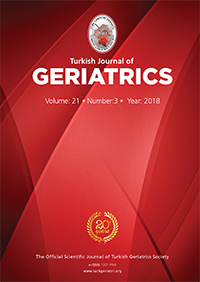2Dr. Burhan Nalbantoglu State Hospital, General practice, Nicosia, Kuzey Kıbrıs TC
3Diyarbakır Yenisehir Community Health Center, General Practitioner, Diyarbakır,Turkey
4Kastamonu Taskopru State Hospital, General Practitioner, Kastamonu, Turkey
5Bismil State Hospital, General Practitioner, Diyarbakır, Turkey DOI : 10.31086/tjgeri.2018344048 Status of non-communicable diseases and some other major health problems and associated risk factors among patients aged 65 years and over presenting to a family health care center in Kyrenia Introduction: The objective of this study was to determine the status of non-communicable (chronic) diseases and some other major health problems and associated risk factors of people aged ?65 years presenting to a family health care center in a county of the Turkish Republic of Northern Cyprus and to contribute to the activities of healthy aging.
Materials and Method: The study was a descriptive record survey, conducted in the primary health care center of Near East University. The data were collected in December 2016 from data collection forms of patients and the NEU Medical Faculty Hospital information database system. The data were evaluated using the SPSS 18.0 statistical program, with a significance level of p<0.05.
Results: The study was conducted on 396 patients aged 65?96 years, of whom 51% were males and 49% were females. The participants were British 95.5% and Turkish Cypriots 1.5%. The most frequent diagnoses were accidents and injuries, ischemic heart disease, hypertension, lower respiratory infections, and cancer. The results of this study were similar to findings of other country older population groups.
Conclusion: Adoption of preventive measures with the aim of decreasing the risk factors of most frequent health-related problems might reduce their prevalence, with specific environmental precautions to prevent accidents and injuries. Prospective community-based studies could provide new data for the proper evaluation of the aging population and yield evidence-based information for designing future intervention studies.
Keywords : Aged; Aging; Chronic disease; Risk factors
